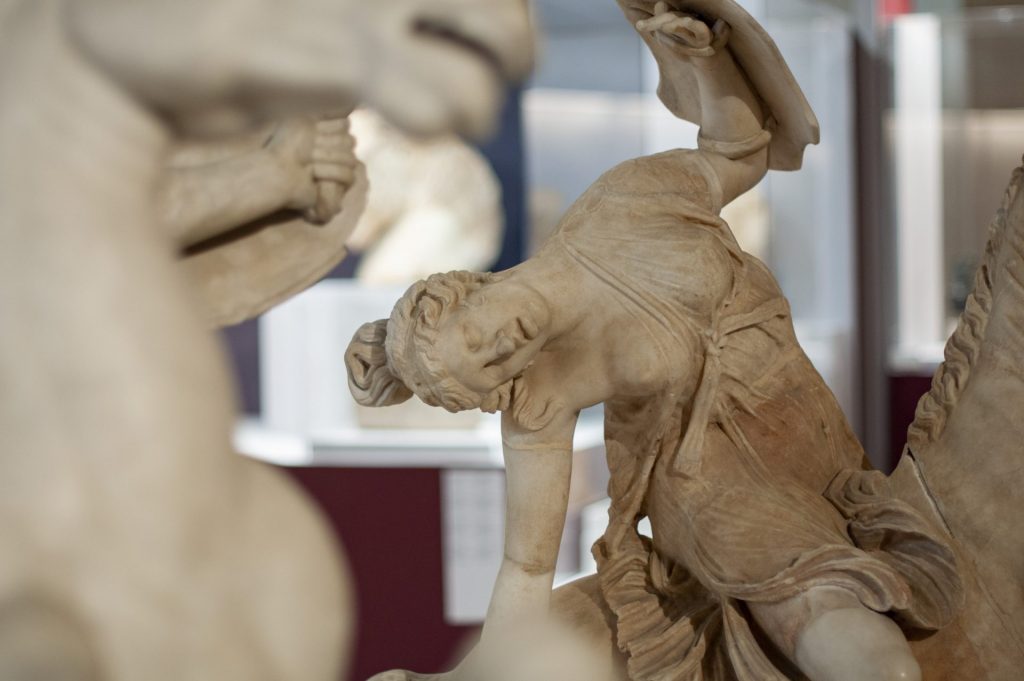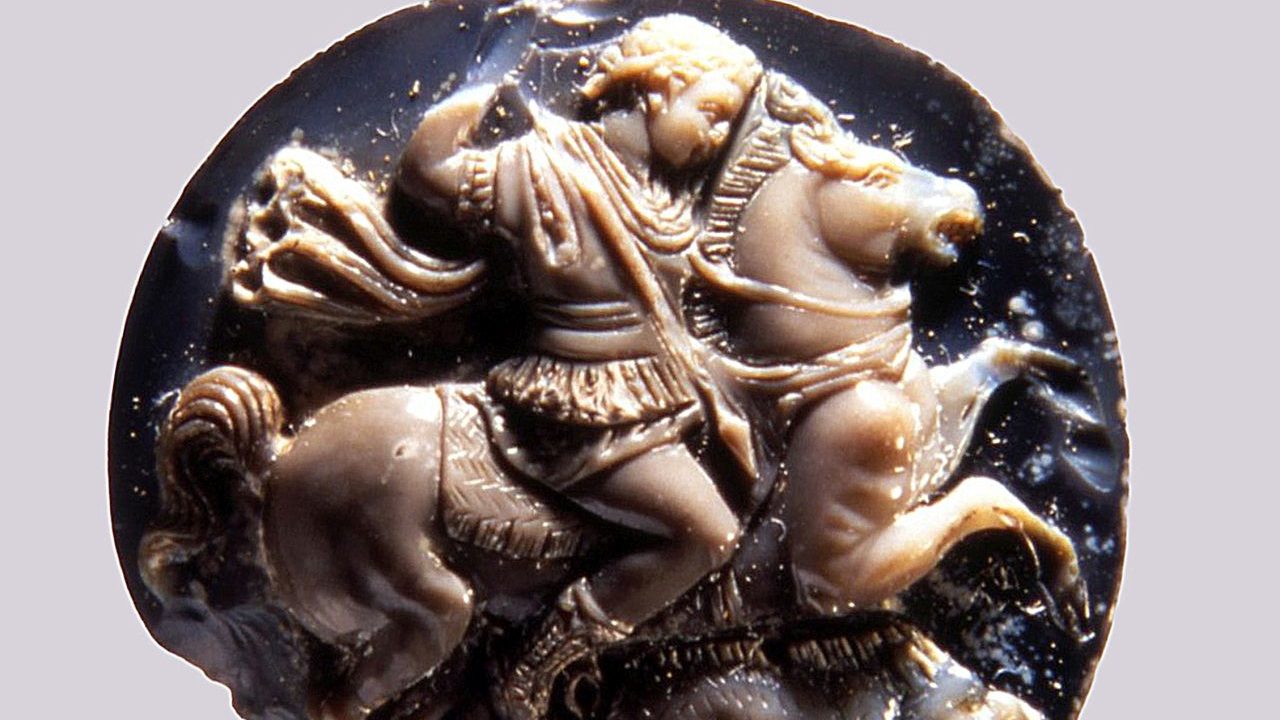Naples has been called many things: operatic, unknowable, as mercurial as Vesuvius, her saturnine and steaming neighbour. But one word I never imagined associating with this extraordinary city was sleepy.
And yet that was the adjective that popped into my head as I explored one of its hidden treasures, a vast cabinet of curiosities that includes many of the greatest finds from the buried Roman settlement of Pompeii. I was at the National Museum of Archaeology of Naples (MANN), an 18th-century palace built for the ruling Bourbon dynasty that is now considered one of the most distinguished repositories of its kind in the world. Its holdings include antiquities from Egypt, as well as sculptures, frescoes and erotic art from the communities on the slopes of the volcano that were destroyed by an eruption in AD79. There’s even an oil lamp said to have been used by the Emperor Nero.
If the Sorbonne in Paris is the acme of polish and sophistication in the humanities, then MANN ought to be the finishing school for every aspiring Indiana Jones. And indeed dedicated, scholarly types – PHDs and professors – have beaten a path to its door and penetrated the unstirring interior. But the place has been largely overlooked by tourists and treated by the Neapolitans themselves as a tiresome traffic island, encircled at all hours by snarling lines of mopeds, taxis, and Fiats under teetering stacks of produce.
A decade ago, it drew 350,000 visitors a year. (It would be unfair to make a direct comparison with the British Museum, situated in the very popular destination of London, but to put MANN’s numbers in some sort of perspective, the BM attracted more than six million people in the same year.) “It was very old school here: kind of dry, not much signage or any other help for the visitor,” says Darius Arya, a dashing TV archaeologist from the United States who has a touch of “Indy” himself. He has rummaged among the stacks at MANN many times in the name of research – and has learned to be patient.
But now the city fathers, and of course the mothers, too, have woken up to the matchless asset on their doorstep. The wind of change is blowing through MANN’s galleries, lifting the dustsheets off its swoon-making marbles. Naples is romancing the stones.
It’s a turnaround as striking, and worthy of celebration, as the footballers of Napoli winning the Scudetto, becoming Italian champions last season for the first time since Diego Maradona led them 30 years ago.
What’s changed is that new leadership has taken charge at the museum and secured €50m (about £43m) from the Italian government and the EU to redevelop the premises. Under its director, Paolo Giulierini, the Egyptian, Greek, and pre-historic galleries have been renovated and installed afresh. Light and airy spaces showcase the superb Farnese sculptures, one of the first collections ever made of art from Greco-Roman antiquity, which were inherited by the Bourbons and moved from the Farnese Villa in Rome to Naples. The set includes a magnificent Hercules and a group of figures with a bull. The former Bourbon ruler, Ferdinand IV, appears as a monumental Minerva by the Italian sculptor Canova. He fills a vast portico set in a great staircase guarded by a marble lion.
The Hercules has a cameo role in a 1953 black and white film, Journey to Italy, by the Italian director Roberto Rossellini. It’s glimpsed in a scene showing Ingrid Bergman visiting the museum, a place of grand empty halls and long shadows. By contrast, the most recent collaboration between MANN and the movies saw the characters of Star Wars stalking the galleries, as figurines and collectibles were installed alongside classical pieces for a child-friendly show.
Giulierini’s overhaul of the institution has taken eight years. As word of the changes has begun to get around, visitor numbers have ticked up, to 670,000 or so before the pandemic. MANN has begun displaying works in rotation from its immense reserves of 230,000 archaeological pieces. Arya said: “The collection here is enormous. There are hundreds of thousands of pieces that we don’t see at the moment. But the museum is getting into the attitude of ‘Let’s cycle through this’. Where did most of the great pieces recovered from Pompeii go? They went here. All kinds of jewels, literally, are going to be unearthed from the archive.”

He’s not kidding. In secret strongrooms located under the eaves of the museum – a corridor of locked and barred cells known to curators as “Sing Sing” – I hold a bronze model of a rabbit in my palm. It’s satisfyingly dense and smooth, like a plutocrat’s paperweight. Recovered from the ruins of Pompeii, it was a domestic familiar, a cherished symbol associated with Venus, the Roman goddess of love.
Visitors are politely requested to don paper overshoes before entering galleries where mosaic floors removed from Pompeii and Herculaneum are on display. This seems entirely reasonable when you discover that your protective slippers are treading on the actual mosaics themselves, one magnificent – and hardy – surface after another. In the UK, needless to say, any sighting of a 2,000-year-old pavement from the days of the Caesars would automatically be accompanied by a rope and sign saying “Keep Off”.
Almost as astonishing as the easy-going attitude to the fixtures and fittings is the revelation that these mosaics were concealed beneath lino and carpet for half a century. For all that time, this wing of the building was out of bounds and unvisited. The museum didn’t have the means, or perhaps the inclination, to open it up to the outside world.
The new thinking doesn’t end with the walkways of antiquity. Prof Eugenio Lo Sardo is watching his exhibition about Alexander the Great take shape beneath a beautiful ceiling fresco in the Salone della Meridiana, which was intended to house a sundial in Bourbon times. The Alexander show has been conceived as a formal curtainraiser for the new-look MANN.
“It’s not the normal view of Alexander as a conqueror but as a man who was also in love with the places where he went. He married a woman from Uzbekistan,” says Lo Sardo. “He was very different from kings in other times and places. He was really a philosopher, a student of Aristotle.”
One of the museum’s most ravishing Alexander artefacts is a giant picture of him routing his adversary, Darius, the Persian leader, in battle. The work dates from 100BC and was uncovered in the 1830s at a villa in Pompeii called the House of the Faun. It’s a Roman mosaic after a painting made by the ancient Greeks.
The Alexander Mosaic, as it’s known, is composed of almost two million tesserae, or tiny tiles, and weighs seven tons. One of the first metalled roads in Italy was constructed to ship it the 16 miles or so from Pompeii to Naples. The museum is embarking on the ticklish process of restoring the work as Lo Sardo’s exhibition opens. He told me: “The mosaic is based on a beautiful, beautiful painting, and the experts think it was made by Apelles, the most famous painter of antiquity.”
“So Alexander may have sat for the painting himself?”
“That’s right.”
The great empire-builder, originally from Macedonia, isn’t the only hero from out of town who is honoured in Naples. I didn’t actually see the Argentine Maradona commemorated in tesserae, but it can only be a matter of time. He is already toasted with a cocktail named after him which is the same satiny blue as the jersey he wore with such distinction.
Artisans who make figurines for nativities in backstreet studios have branched out into plaster busts of the player. He is seen wearing a mitre and robes like San Gennaro, the city’s nominal patron saint, except that his vestments are in Napoli’s colours of blue and white.
The man who will always be remembered by England fans for his “hand of God” goal looks on beatifically from banners and murals in the old city, where the party started by Napoli’s success is still going strong amid the steepling tenements.
“It’s an earthquake of joy,” says Gaetano Manfredi, the mayor of Naples, and he ought to know: his worship has a background in seismic engineering. Taking the Serie A title, and the buzz around the reimagined museum, gives Naples a reputation as a city that wins, a city in a positive mood, he told me. “MANN used to be a place for the elite, people with a high cultural level. Now I think the museum must be a democratic place which all people can access, especially young people. A new generation has a different approach to the museum.”
If archaeology teaches us anything, it’s about taking the long view. What will the renaissance of MANN do for the cultural life of Naples, and of Italy? Putting a museum’s neglected masterpieces in the shop window is the easy part of the trick; attracting and keeping a new audience, that’s a whole other level of pulling a rabbit out of the hat.
Alexander the Great and the East: Discoveries and Wonders is at MANN until August 28



